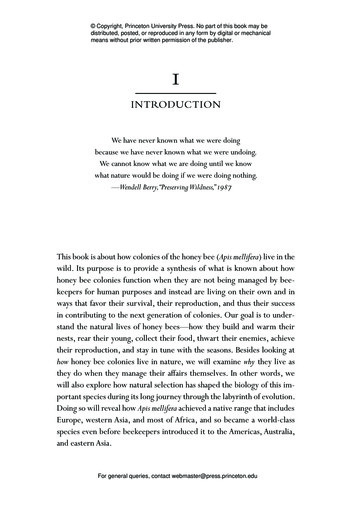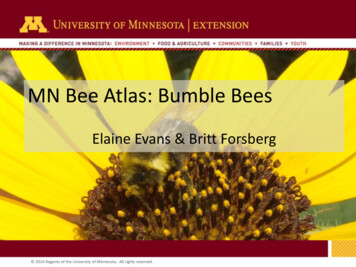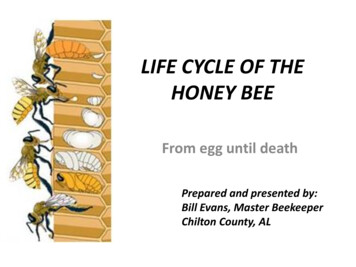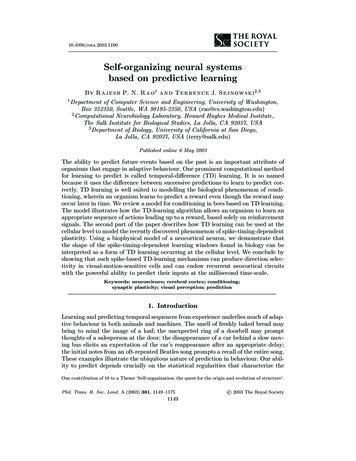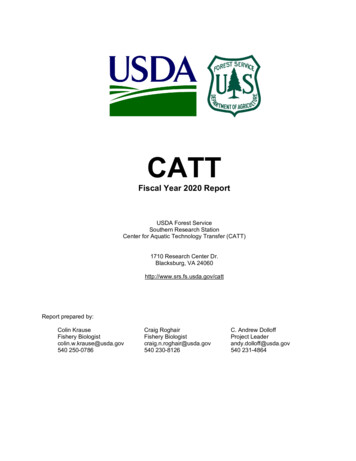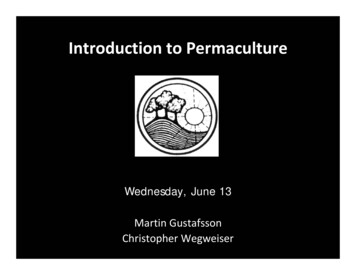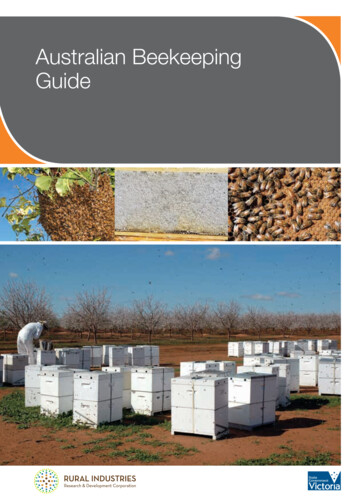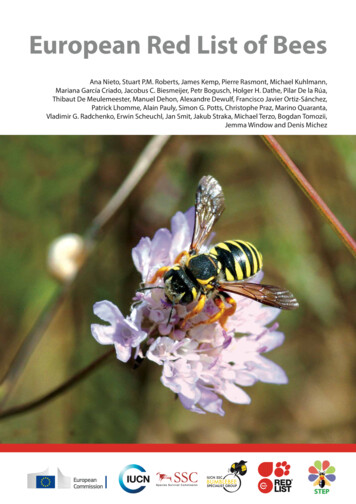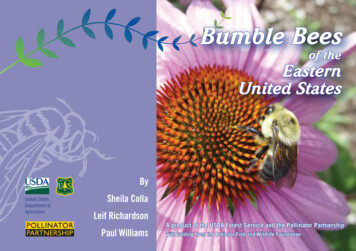
Transcription
Bumble Beesof theEasternUnited StatesByUnited StatesDepartment ofAgricultureSheila CollaLeif RichardsonPaul WilliamsA product of the USDA Forest Service and the Pollinator Partnershipwith funding from the National Fish and Wildlife Foundation
Executive EditorExecutive and Managing EditorGraphic Design and Art DirectionAdministrationIllustrationsIT Production SupportLarry Stritch, Ph.D., USDA Forest ServiceLaurie Davies Adams, The Pollinator PartnershipMarguerite MeyerJennifer Tsang, The Pollinator PartnershipAlison Boyd, The Pollinator PartnershipElizabeth Sellers, National Biological InformationInfrastructure, U.S. Geological SurveyCover: Male Bombus griseocollisforaging at cultivated coneflower.Photo Leif Richardson2Bumble Bees of the Eastern United States
Guide toBumble Beesof theTable of Contents3Table of Contents4Foreword5About the Authors6Introduction10Bee Diagrams13Map Methodology14Species Guides (color coded)EasternUnited States14-41Long- or square-cheeked bees with a rounded angle on the midleg42-61Short-cheeked bees with a rounded angle on the midleg62-77Long-cheeked bees with a sharp angle on the midleg78-97Bees with hindleg outer tibial surface convex and uniformly hairy (cuckoo bumble bees)98Identification Key102Acknowledgements103Web and Other ResourcesBumble Bees of the Eastern United States3
ForewordHome bookshelves, school libraries,nature centers, and museum gift shopsare crowded with dozens of recent field guides to the North American faunaand flora. Naturalists, young and old, inexperienced and seasoned professionals, have access to illustrated guides of all types of exciting organisms,living and dead. But where are the bee identification field guides? Morethan 4,000 species of native bees in the United States and Canada aregenerally small and lead hidden lives, going mostly unnoticed by almosteveryone. Bigger bees, like bumble bees and carpenter bees, get noticed, asdo the omnipresent brown and black-striped worker honey bees.commonly encountered bumble bees. Each bee species has informationon preferred food plants, nesting biology, and similar species, along withthe seasonal activity patterns for adults at flowers. Closely cropped colorphotographs illustrate key color patterns and floral behaviors, while macroimages highlight morphological characteristics and species-level differences. Additionally, there are detailed dot distribution maps and dichotomousidentification keys for each of the 21 species. The key refers to diagrammatic “torpedo style” color illustrations of the typical colors for castes ofeach species. Much of the information is presented together for the firsttime (e.g., dot distribution maps of species ranges).Bee identification, including family, genus, and species level, usually involves highly focused specialized training. Bird and butterfly identificationis comparatively easy, which is why there are more bird watchers than bugwatchers and why there are almost no guides available for bee identification. The earlier a student of bees adopts professionally recognized scientificnames for bee groups, the easier it becomes.This new guide is an authoritative tool for learning about our rich and variedbumble bee fauna. This field guide will enable people to identify, name, andfurther explore the colorful and charming bumble bees. This guide encourages exploring nature firsthand from a new perspective. As one youngscientist said, “I really like bumble bees because they are so fuzzy and cute.It’s hard not to like them.” With the Guide to Eastern Bumble Bees, we notonly admire the Bombus of the East, we can also identify, understand, andsupport them as well. Like the canary in the coal mine, several bumblebees of the eastern region (Bombus terricola, Bombus pensylvanicus, andespecially Bombus affinis) have declined dramatically across their formerwide distributions in the past decade. With the proper identification tools,students and citizen scientists can help professional entomologists tracktheir populations and learn why we are losing these essential pollinators.Typically in bumble bee identification, voucher specimens must be collectedand compared side-by-side with museum specimens. The specimen isidentified using complex professional keys buried in old and hard-to-findliterature. An anonymous quotation captures the complexity of bee identification: “taxonomic keys are written by individuals who don’t need them forothers who can’t understand them.”The Guide to Eastern Bumble Bees is an indispensible new bumble beeidentification resource for the Eastern United States. For the first time,melittologists (scientists who study bees) Colla, Richardson, and Williamsprovide an easy-to-use illustrated and engaging field guide to the most4Bumble Bees of the Eastern United StatesStephen Buchmann, Ph.D.International Coordinator North American Pollinator Protection Campaign(NAPPC), Co-author of “The Forgotten Pollinators”
About the AuthorsSheila R. Colla has studied variousaspects of bumble bee ecology, behavior,and conservation throughout NorthAmerica. She is currently a doctoralstudent and recipient of the NaturalSciences and Engineering ResearchCouncil Alexander Graham Bell CanadianGraduate Scholarship at York Universityunder the supervision of Dr. LaurencePacker in Toronto, Ontario, Canada. Herdissertation examines changes in bumblebee communities over the past centuryand looks into some of the causes forobserved declines. In addition, she is amember of the North American PollinatorProtection Campaign and her researchhas been featured in The WashingtonPost, Canadian Gardening, The TorontoStar, BioScience, CBC’s Quirks andQuarks, and The Daily Planet forDiscovery Channel Canada.Email: scolla@yorku.caWebsite: www.savethebumblebees.comLeif Richardson is a graduate studentat Dartmouth College, where he is doingdissertation research on plants andtheir pollinators. He holds a master’sdegree from the University of Arizona’sDepartment of Ecology and EvolutionaryBiology and worked for many years as anecologist with the Vermont Department ofFish and Wildlife’s Nongame and NaturalHeritage Program. He is documenting thedistribution and decline of bumble beesin New England and is involved in effortsto conserve bumble bee populations inEastern North America.Email: leif.l.richardson@dartmouth.eduPhone: 802-225-6353Paul Williams studied the distributionand decline in British bumble bees for aPh.D. at Cambridge (UK) in 1985. Sincethen, he has continued to work on thisas a research entomologist at the NaturalHistory Museum, London, UK, but islooking increasingly at bumble beeecology and systematics worldwide, withfield work especially in North America,the Himalaya, and China. Largertaxonomic publications have includedfaunal revisions of the bumble beesof Kashmir and more recently on thebumble bees of Sichuan, on a checklistof bumble bee species of the world, andon a series of papers on bumble beephylogeny and subgenera.Overview: www.nhm.ac.uk/bombusPublications on bumble bees: www.nhm.ac.uk/bombus/publications.htmlAuthors are listed in alphabetical order. Each contributed equally.Bumble Bees of the Eastern United States5
IntroductionBumble Beesof theBumble bee taxonomyand biogeographyEasternUnited StatesPhylum Arthropoda,Class Insecta,Subclass Pterygota,Order Hymenoptera,Suborder Apocrita,Infraorder Aculeata,Superfamily Apoidea,Family Apidae,Subfamily Apinae,Genus BombusThe genus Bombus (bumble bee) includes approximately250 species found primarily in temperate regions ofNorth America, Central America, South America, Europe,and Asia. They are absent from Australia, lowland India,and from most of Africa. In the United States, in Stateswhose boundaries are fully east of the 100th meridian,there are a total of 21 species.6Bumble Bees of the Eastern United StatesThe common and easily recognized bumble bees are largeand furry corbiculate (i.e., they have smooth areas onthe hindlegs surrounded by stiff bristles for transportingpollen) bees with no jugal lobe to the hindwing. Allspecies are eusocial except for members of thesubgenus Psithyrus, which are social parasites that invadehost bumble bee nests to produce offspring.
Natural HistoryBumble bees have the rare physiological capability(among insects) to choose to thermoregulate. Theyare able to generate heat in their thoracic muscles, byshivering, to reach the required minimum temperaturefor flight (approx. 30 C). Given that bumble bees fly inthe spring and fall in temperate regions, this internaltemperature can be well above ambient temperature.Bumble bees rely entirely on flowering plants for food.Adults feed primarily on nectar for energy to fuel flight,but feed their larvae primarily on pollen to provide proteinfor growth. Bumble bees are considered to be generalistforagers. Because of the length of their colony cycles,bumble bees usually need to feed from a variety of plantspecies, including native wildflowers, crop plants, andintroduced species. As can be seen in the followingspecies pages, there are differences between species intiming of emergence, length of colony cycle, foragingbehavior, and habitat selection.The length of the bumble bee’s tongue governs itsfood-plant choices, with bees preferring flowers with asimilar depth to their own tongue length, as this tendsto maximize the rate at which they can gather nectar.Tongue length varies with body size within species, butalso varies among species. Therefore different bumblebee species with different tongue lengths tend to visitdifferent food-plant species, resulting in some partitioningof food-plant usage among bumble bee species. This mayhave the effect of reducing competition between bumblebee species in a community.The Colony CycleBumble bees are eusocial organisms with annual coloniesin North America (i.e., one year one generation). Thismeans bumble bees live in colonies comprised of severaldifferent ‘castes’ who divide the reproductive, foraging,Bumble Bees of the Eastern United States7
defense, and other tasks necessary to their survival. Reproductivefemales, or ‘queens,’ live with their male and female offspring,and all employ an array of physiological and behavioraladaptations for communication. Mated queens emerge fromhibernation in the spring after overwintering and begin feeding.Spring queens search for a suitable nest site where they thenbegin their colonies. Eggs hatch after approximately 4 days andthe small larvae begin to feed on pollen mixed with nectar. Thelarval stage of bumble bees has four instars. After almost 2 weeksof development, the larvae spin cocoons and pupate. Pupaedevelop for another 2 weeks before emerging as full-sized adults.In total, development takes approximately 5 weeks but this varieswith temperature and food supply. First, female workers emergeand begin foraging for the colony and feeding the brood. Asthe summer progresses, the colony reaches maximum workerproduction and begins producing males and potential queens.These reproductive individuals leave the nest and mate. Aftermating, young queens enter diapause and overwinter. The malesand the rest of the colony die with the onset of cold weather inlate fall.Bumble bee species vary according to how they store pollen andfeed developing larvae. ‘Pollen storers’ accumulate pollen for lateruse, often re-using vacated cocoons for this (e.g., B. terricola).The queen and workers feed each larva individually, opening theirbrood cells to regurgitate a mixture of pollen and nectar for them.By contrast, ‘pocket makers’ place pollen directly in a wax pocketon the side of a group of larval cells (e.g., B. fervidus). The larvaeof these species all feed from the same pocket, which sometimesleads to greater size differences in adult bees of the same caste.8Bumble Bees of the Eastern United States
Bumble bee species belonging to the subgenus Psithyrusare an exception as they do not produce a worker caste,but are social parasites. Females usurp colonies of otherspecies and reproduce using the host species’ resources. Inthe eastern fauna, the parasitic species are: B. ashtoni, B.citrinus, B. fernaldae, B. insularis, B. variabilis.Importance inNatural Ecosystemsand AgricultureBumble bees are extremely important pollinators foragriculture both in the field and in greenhouses. Unlikehoney bees, they are able to forage under cold, rainy, andcloudy conditions. This makes them excellent pollinatorsfor a variety of crops in temperate regions. Some cropsthat bumble bees can pollinate include tomatoes,peppers, raspberries, blueberries, chives, cucumbers,apples, strawberries, alfalfa, blackberries, soybeans,sunflowers, beans, cherries, apricots, plums, almonds,nectarines, peaches, rosehips, eggplants, and cranberries.Bumble bees are also extremely important pollinators ofmany flowering plants throughout the native ranges withwhich they co-evolved mutualisms where they receivefood in return for providing pollination. Bumble bees aregeneralists and have been recorded visiting hundreds ofnative plant species. The pollination services bumblebees provide for native plants are likely very importantfor maintaining various ecosystems. In addition, otheranimals, like small mammals and birds, rely on the fruitsand seeds of pollinated plants for food.Bumble Bee DeclinesWe have evidence that in North America some ofour bumble bee species are declining and a few arethreatened with extinction. One species from Oregonand California (Franklin’s bumble bee) has recently beenlisted by the International Union for Conservation ofNature (IUCN) as Critically Endangered. Species thatseem most vulnerable are those with smaller climatetolerances, those at the edge of their climatic niches,and later emerging species. In North America, membersof the subgenus Bombus sensu strictu (i.e., B. affinis,B. occidentalis, B. franklini, B. terricola) seem to bedeclining at a rapid rate.Currently, the suspected threats to wild bumble bees are:habitat loss due to agricultural intensification,urbanization or pollution,pesticide use,pathogen spillover from managed bees,and climate change.Bumble Bees of the Eastern United States9
Bee Body eg4abdomen(withnumberedterga/ “T”56corbiculum/pollen basketBombus ternarius, queen10Bumble Bees of the Eastern United States
Bee Leg Diagrammidlegtibiatarsal segmentsfemurbasitarsushindlegBombus bimaculatus, maleBumble Bees of the Eastern United States11
Bee Face Diagramsupraorbital lineocelliantennaclypeuscompound eyecheek (malar space)mandibleBombus sandersoni, worker12Bumble Bees of the Eastern United Statestongue
Map MethodologyThe maps produced for this guide provide two sets of informationabout the range of each species: points that represent actual bumblebee collections, and generalized range polygons meant to predict beedistribution in areas where we lack specimen collection data. Manyinstitutions and individuals have contributed digitized, georeferencedspecimen data to this effort, and dots on each map representcollections held by the following:Sheila Colla, York UniversityPaul Williams, British Natural History MuseumLeif Richardson, Vermont Department of Fish and WildlifeCaroline Scully, Antioch University New EnglandJohn Ascher, American Museum of Natural HistoryOhio State University Hymenoptera Online DatabaseIllinois Natural History SurveyYale University, Peabody MuseumUniversity of Connecticut Insect CollectionsUniversity of Vermont’s Zadock Thompson Zoology CollectionCanadian National Collection of InsectsRachael Winfree, Rutgers UniversitySam Droege, U.S. Geological Survey, Patuxent Wildlife ResearchCenterMichael Arduser, Missouri Department of ConservationH.E. Milliron (published records from various collections)Kevin Matteson, Fordham UniversitySteve Marshall, University of GuelphMany other insect collections exist that have not been checked foridentification accuracy or digitized. These maps can thus be improvedupon as more data become available.Maps are at a scale of 1:11,000,000. For each species, a rangepolygon (shown in green) was produced by buffering specimencollection points by 100 kilometers, then merging all buffers together.We chose this as an arbitrary distance from known locations ofoccurrence (i.e., sites where specimens have been collected) because,in general, we believe that it helps to describe a bumble bee species’range. Minor changes were made to the resulting layer to connectadjacent polygons where we thought it appropriate, to smooth someedges and to improve the presentation of the map. The range polygonlayer was then clipped to the Eastern United States. No range polygonwas made for B. frigidus, because we currently know of just onespecimen of this bee collected in the Eastern United States.For each species, the specimen collection points from the EasternUnited States are displayed. Data from most sources listed above aretermed ‘Primary Records,’ because we have high confidence in thedeterminations (identifications) of those specimens. Data from theOhio State University collection are termed ‘Other Records,’ becausewe have not verified the determinations of bees in that collection. In afew cases, we have also displayed points on the maps that representphotographs of bumble bees, not actual collections. We have only donethis when accurate identification was possible from a photo.For three species that have undergone precipitous declines in the lastdecade—B. affinis, B. terricola, and B. ashtoni—we chose to displaythe relatively few collections made after 1997 differently from allthose made previously. This is intended to give the reader a sense ofhow much the species’ ranges have shrunk and where they might stillbe found.Range information is shown for all full States east of the 100 longitude line. Users should bear in mind that most of the bumblebees found in this area also occur in parts of adjacent Canada and theWestern United States.Bumble Bees of the Eastern United States13
Bombus impatiensCommon eastern bumble bee Common, possibly expanding range Select food plants: Cirsium (Thistles), Eupatorium, Gelsemium,Solidago (Goldenrods), Pontederia (Pickerel Weeds) Tongue length: medium Nests underground Parasitized by B. citrinus Can be confused with B. bimaculatusPhenology bus impatiens worker foraging on cultivated sunflowerPhoto Leif Richardson14Bumble Bees of the Eastern United States
Bombus impatiens continuedLong- or square-cheeked bees witha rounded angle on the midlegLateral image of a female Bombus impatiens.Photo Sheila CollaFemale Bombus impatiensface. Photo Sheila CollaBombus impatiens queen foraging on clover.Photo Sheila CollaBombus impatiens male on oregano.Photo Leif RichardsonBombus impatiensmale on aster.Photo Sheila CollaBumble Bees of the Eastern United States15
Bombus impatiens continued16Bumble Bees of the Eastern United States
Bombus impatiens continuedFemales (queens and workers, colors refer to pile or ‘hair’): Thorax and T1 predominantly pale yellow, some blackhairs intermixed between the wing bases,T2 entirely black, tail black. Midleg basitarsus with the distal posterior cornerrounded. Cheek as long as broad. Hair of the faceblack or with only a few yellow hairs intermixed, blackhairs intermixed diffusely between the wing bases,hair of T2 always entirely black. Hair short, metasomarather long and rectangular.Bumble Bees of the Eastern United States17
Bombus bimaculatusTwo-spotted bumble bee Common Select food plants: Cirsium (Thistles),Hypericum (St. John’s Wort),Melilotus (Sweet Clovers), Rosa, Solidago (Goldenrods),Vicia (Vetches) Tongue length: medium Nests underground and on surface Can be confused with B. impatiens, B. griseocollis,Phenology e Bombus bimaculatus foraging at wild bergamot.Photo Leif Richardson18Bumble Bees of the Eastern United States
Bombus bimaculatus continuedLateral image of a femaleBombus bimaculatus.Photo Sheila CollaBombus bimaculatus worker.Photo Sheila CollaBombus bimaculatus queen foraging fornectar from cultivated azaleas.Photo Leif RichardsonBombus bimaculatus face.Photo Sheila CollaBumble Bees of the Eastern United States19
Bombus bimaculatus continued20Bumble Bees of the Eastern United States
Bombus bimaculatus continuedFemales (queens and workers, colors refer to pile or ‘hair’): Thorax and T1 predominantly yellow, a black spot between thewing bases, T2 usually with a yellow W in the middle, tail black,hair long. Midleg basitarsus with the distal posterior corner rounded.Cheek slightly longer than broad. Hair of face black or with onlya few yellow hairs intermixed, black hair of the spot betweenthe wing bases dense and always present, although oftenwith yellow hairs intermixed, the black hairs only occasionallyforming a band between the wing bases, T2 alwayswith some yellow hairs present but sometimes withvery few, although if the yellow is extensive thenblack hairs are intermixed posteriorly and mediallyand the posterior margin of the yellow usually forms acharacteristic W-shape (which may be similar in someB. griseocollis, although that species usually has someyellow hairs rather than black anterio-laterally). Hairlong and uneven, metasomarather short and globular.Bumble Bees of the Eastern United States21
Bombus perplexusConfusing bumble bee Common Select food plants: Hydrangea, Rhododendron, Rubus,Vaccinium, Lonicera (Honeysuckles), Prunus, Ribes Tongue length: medium Nests on ground surface and in hollow logs and trees Can be confused with B. vagansBombus perplexus worker foraging on St. John’s Wort.Photo Leif RichardsonPhenology ChartMalesWorkersQueensAPR22MAYJUNEJULYBumble Bees of the Eastern United StatesAUGSEPTOCT
Bombus perplexus continuedLateral image of a female Bombus perplexus.Photo Sheila CollaBombus perplexus male.Photo Sheila CollaBombus perplexus queen.Photo Leif RichardsonFemale Bombus perplexus face.Photo Sheila CollaBumble Bees of the Eastern United States23
Bombus perplexus continued24Bumble Bees of the Eastern United States
Bombus perplexus continuedFemales (queens and workers, colors refer to pile or ‘hair’): Thorax and T1-2 predominantly brown or yellow, sidesof the thorax often black, tail black or often with somewhite hairs. Midleg basitarsus with the distal posterior cornerrounded. Cheek slightly longer than broad. Hair ofthe face black or with yellow hairs intermixed, onlya very few inconspicuous black hairs in the centre ofthe thoracic dorsum between the wing bases, sidesof the thorax often but not always extensively black,sometimes entirely yellow. Pale hair often brownishrather than yellow, T5 sometimes with white hair.Hair long.Bumble Bees of the Eastern United States25
Bombus vagansHalf-black bumble bee Common Select food plants: Penstemon (Beard-Tongues),Asclepias (Milkweeds), Asters, Cirsium (Thistles),Eupatorium, Spirea (Meadowsweet), Tongue length: medium Nests on ground surface and underground Unlike most bumble bees, this species readily foragesin heavily shaded areas within forests Can be confused with B. sandersoni, B. perplexus,B. affinis Parasitized by B. citrinusPhenology ChartA worker Bombus vagans visits red clover.Photo Leif RichardsonMalesWorkersQueensAPR26MAYJUNEJULYBumble Bees of the Eastern United StatesAUGSEPTOCT
Bombus vagans continuedLateral image of a Bombus vagans female.Photo Sheila CollaFemale Bombus vagans face.Photo Sheila CollaBumble Bees of the Eastern United States27
Bombus vagans continued28Bumble Bees of the Eastern United States
Bombus vagans continuedFemales (queens and workers, colors refer to pile or ‘hair’): Thorax and T1-2 predominantly yellow, a black spotbetween the wing bases, sides of the thorax yellow, tailblack, face long. Midleg basitarsus with the distal posterior cornerrounded. Cheek slightly longer than broad. Hair of theface black or with yellow hairs intermixed, the blackthoracic spot between the wing bases may be small andintermixed with yellow hairs in queens but is larger andmore diffuse in workers, forming a band between thewing bases, T2 yellow or sometimes with black along theposterior margin, sometimes intermixed laterally, but notanteriorly unless the yellow band is very narrow. Hairlong. Body size small, but larger than B. sandersoni.Bumble Bees of the Eastern United States29
Bombus sandersoniSanderson bumble bee Uncommon Select food plants: Epilobium, Monarda (Bee Balms),Penstemon (Beard Tongues), Rubus, Malus (Apples) Tongue length: short Often confused with B. perplexus and B. vagans.Difficult to properly identify and this ecology poorly known.Phenology ChartMalesWorkersQueensAPR30MAYJUNEJULYBumble Bees of the Eastern United StatesAUGSEPTOCTBombus sandersoni female in Newfoundland, Canada.Photo Cory Sheffield
Bombus sandersoni continuedLateral image of a Bombus sandersoni female.Photo Sheila CollaLateral image of Bombus sandersoni female, dark morph.Photo Sheila CollaFemale Bombus sandersoni face.Photo Sheila CollaBumble Bees of the Eastern United States31
Bombus sandersoni continued32Bumble Bees of the Eastern United States
Bombus sandersoni continuedFemales (queens and workers, colorsrefer to pile or ‘hair’): Thorax and T1-2 predominantlyyellow, or with a black spot or bandbetween the wing bases, sidesof the thorax yellow, tail black oryellow or occasionally white (notorange), face round. Midleg basitarsus with the distalposterior corner rounded. Cheekas long as, or slightly shorter than,broad. Hair of the face and top ofthe head black or with yellow hairs,corbicular fringes black or withbrownish-orange tips, T2 anteriolaterally often with a few scatteredblack hairs intermixed, T5 black,brown, yellow, or white, with a fewblack hairs intermixed. Hair shortand even, body size small andsmaller than B. vagans.Bumble Bees of the Eastern United States33
Bombus frigidusBombus frigidus Rare in the United States (recorded only in northern borderStates) Select food plants: Cirsium (Thistles),Epilodium Geranium, Mertensia (Bluebells),Taraxacum officinale (Dandelion), Trifolium (Clovers) Tongue length: shortThe phenology for this species is unknown due to few records in the Eastern United States.Bombus frigidus worker on senecio sp.Photo Jessica Forrest34Bumble Bees of the Eastern United States
Bombus frigidus continuedLateral image of a female Bombus frigidus.Photo Sheila CollaFemale Bombus frigidus face.Photo Sheila CollaBumble Bees of the Eastern United States35
Bombus frigidus continued36Bumble Bees of the Eastern United States
Bombus frigidus continuedFemales (queens and workers, colors refer to pile or ‘hair’): Thorax and T1-2 predominantly yellow, with a blackband between the wing bases, sides of the thoraxyellow, tail orange (occasionally faded to moreyellowish). Midleg basitarsus with the distal posterior cornerrounded. Cheek as long as broad. Hair of the faceblack or with some yellow hairs, corbicular fringesextensively pale orange, T2 anterio-laterally withoutscattered black hairs intermixed. Hair long.Bumble Bees of the Eastern United States37
Bombus ternariusTri-colored bumble bee Common Select food plants: Asclepias (Milkweeds), Rubus, Solidago(Goldenrods), Rhododendron, Vaccinium Tongue length: short Nests underground Can be confused with the red color morph of B. rufocinctusPhenology ChartMalesBombus ternarius queen visits dandelion.Photo Leif RichardsonWorkersQueensAPR38MAYJUNEJULYBumble Bees of the Eastern United StatesAUGSEPTOCT
Bombus ternarius continuedLateral image of a Bombus ternarius female.Photo Sheila CollaMale Bombus ternarius onCanada goldenrod.Photo Sheila DumeshFemale Bombus ternarius face.Photo Sheila CollaA Bombus ternarius workervists cultivated bush pea.Photo Leif RichardsonBumble Bees of the Eastern United States39
Bombus ternarius continued40Bumble Bees of the Eastern United States
Bombus ternarius continuedFemales (queens and workers, colors refer to pile or ‘hair’): Thorax and T1 predominantly yellow, with a black bandbetween the wing bases extending posteriorly in themiddle of the scutellum, T2-3 orange, T4 yellow, T5black, and with face round. Midleg basitarsus with the distal posterior cornerrounded. Cheek very slightly shorter than broad.Hair of face and top of the head black with patchesof yellow, or sometimes with black more extensivelyintermixed, especially for workers. Thoracic anteriorband usually yellow without black hairs intermixedexcept in some workers, which have the anterior marginof the black band between the wing bases alwayssharply defined. Scutellum with yellow patches entirelydivided by a black, posteriorly directed triangle. T2red, at most with a few black hairs anterio-medially; T4yellow; T5 black. Hair short and even.Bumble Bees of the Eastern United States41
Bombus terricolaYellow-banded bumble bee Uncommon, possibly declining since the mid-1990s Select food plants: Vaccinium, Salix (Willows), Rosa (Roses),Rubus, Lonicera (Honeysuckles), Solidago (Goldenrods), Asters Tongue length: short Nests underground Nectar robber Parasitized by B. ashtoni Can be confused with B. pensylvanicusPhenology bus terricola worker collecting nectar from milkweed.Photo Leif Richardson42Bumble Bees of the Eastern United States
Bombus terricola continuedShort-cheeked bees with arounded angle on the mid legLateral image of a female Bombus terricola.Photo Sheila CollaBombus terricola worker visiting purple flowering raspberry.Photo Leif RichardsonBombus terricola male forages on hop clover.Photo Leif RichardsonFemale Bombus terricola face.Photo Sheila CollaBumble Bees of the Eastern United States43
Bombus terricola continued44Bumble Bees of the Eastern United States
Bombus terricola continuedFemales (queens and worker
2 Bumble Bees of the Eastern United States Executive Editor Larry Stritch, Ph.D., USDA Forest Service Executive and Managing Editor Laurie Davies Adams, The Pollinator Partnership Graphic Design and Art Direction Marguerite Meyer Administration Jennifer Tsang, The Pollinator Partnership Illustrations Alison
